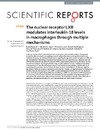Identificador persistente para citar o vincular este elemento:
https://accedacris.ulpgc.es/jspui/handle/10553/21773
| Campo DC | Valor | idioma |
|---|---|---|
| dc.contributor.author | Pourcet, Benoit | en_US |
| dc.contributor.author | Gage, Matthew C. | en_US |
| dc.contributor.author | León, Theresa E. | en_US |
| dc.contributor.author | Waddington, Kirsty E. | en_US |
| dc.contributor.author | Pello, Oscar M. | en_US |
| dc.contributor.author | Steffensen, Knut R. | en_US |
| dc.contributor.author | Castrillo Viguera, Antonio | en_US |
| dc.contributor.author | Valledor, Annabel F. | en_US |
| dc.contributor.author | Pineda-Torra, Inés | en_US |
| dc.date.accessioned | 2017-05-17T02:30:47Z | - |
| dc.date.accessioned | 2018-03-16T09:14:47Z | - |
| dc.date.available | 2017-05-17T02:30:47Z | - |
| dc.date.available | 2018-03-16T09:14:47Z | - |
| dc.date.issued | 2016 | en_US |
| dc.identifier.issn | 2045-2322 | en_US |
| dc.identifier.other | Scopus | - |
| dc.identifier.uri | https://accedacris.ulpgc.es/handle/10553/21773 | - |
| dc.description.abstract | IL-18 is a member of the IL-1 family involved in innate immunity and inflammation. Deregulated levels of IL-18 are involved in the pathogenesis of multiple disorders including inflammatory and metabolic diseases, yet relatively little is known regarding its regulation. Liver X receptors or LXRs are key modulators of macrophage cholesterol homeostasis and immune responses. Here we show that LXR ligands negatively regulate LPS-induced mRNA and protein expression of IL-18 in bone marrowderived macrophages. Consistent with this being an LXR-mediated process, inhibition is abolished in the presence of a specific LXR antagonist and in LXR-deficient macrophages. Additionally, IL-18 processing of its precursor inactive form to its bioactive state is inhibited by LXR through negative regulation of both pro-caspase 1 expression and activation. Finally, LXR ligands further modulate IL-18 levels by inducing the expression of IL-18BP, a potent endogenous inhibitor of IL-18. This regulation occurs via the transcription factor IRF8, thus identifying IL-18BP as a novel LXR and IRF8 target gene. In conclusion, LXR activation inhibits IL-18 production through regulation of its transcription and maturation into an active pro-inflammatory cytokine. This novel regulation of IL-18 by LXR could be applied to modulate the severity of IL-18 driven metabolic and inflammatory disorders. | en_US |
| dc.format | application/pdf | - |
| dc.language | eng | en_US |
| dc.relation.ispartof | Scientific Reports | en_US |
| dc.rights | by-nc-nd | - |
| dc.source | Scientific Reports [ISSN 2045-2322], v. 6 (article number 25481) | en_US |
| dc.subject | 3206 Ciencias de la nutrición | en_US |
| dc.subject | 230219 Procesos metabólicos | en_US |
| dc.subject.other | Liver X-Receptor | en_US |
| dc.subject.other | Sequence-Binding-Protein | en_US |
| dc.subject.other | Gamma-Inducing Factor | en_US |
| dc.subject.other | Gene-Expression | en_US |
| dc.subject.other | Ifn-Gamma | en_US |
| dc.subject.other | Nlrp3 Inflammasome | en_US |
| dc.subject.other | Cell-Function | en_US |
| dc.subject.other | Bone-Marrow | en_US |
| dc.subject.other | Arginase 1 | en_US |
| dc.subject.other | Il-18 | en_US |
| dc.title | The nuclear receptor LXR modulates interleukin-18 levels in macrophages through multiple mechanisms | en_US |
| dc.type | info:eu-repo/semantics/Article | en_US |
| dc.type | Article | en_US |
| dc.identifier.doi | 10.1038/srep25481 | en_US |
| dc.identifier.scopus | 2-s2.0-84966990623 | - |
| dc.identifier.isi | 000375418700001 | - |
| dc.contributor.authorscopusid | 14527636000 | - |
| dc.contributor.authorscopusid | 24830499600 | - |
| dc.contributor.authorscopusid | 57197235257 | - |
| dc.contributor.authorscopusid | 56767870000 | - |
| dc.contributor.authorscopusid | 11840220100 | - |
| dc.contributor.authorscopusid | 6603943805 | - |
| dc.contributor.authorscopusid | 55445301000 | - |
| dc.contributor.authorscopusid | 6602429316 | - |
| dc.contributor.authorscopusid | 7801465530 | - |
| dc.identifier.crisid | -;-;-;-;-;-;-;-;- | - |
| dc.identifier.eissn | 2045-2322 | - |
| dc.relation.volume | 6 | en_US |
| dc.investigacion | Ciencias | en_US |
| dc.project.reference | G0801278; PG/13/10/30000; SAF2014-56819-R; SAF2014-57856 | - |
| dc.rights.accessrights | Acceso libre | - |
| dc.type2 | Artículo | en_US |
| dc.contributor.daisngid | 2142767 | - |
| dc.contributor.daisngid | 618713 | - |
| dc.contributor.daisngid | 2583241 | - |
| dc.contributor.daisngid | 4557397 | - |
| dc.contributor.daisngid | 1295127 | - |
| dc.contributor.daisngid | 301130 | - |
| dc.contributor.daisngid | 225640 | - |
| dc.contributor.daisngid | 1019812 | - |
| dc.contributor.daisngid | 7387206 | - |
| dc.utils.revision | Sí | en_US |
| dc.contributor.wosstandard | WOS:Pourcet, B | - |
| dc.contributor.wosstandard | WOS:Gage, MC | - |
| dc.contributor.wosstandard | WOS:Leon, TE | - |
| dc.contributor.wosstandard | WOS:Waddington, KE | - |
| dc.contributor.wosstandard | WOS:Pello, OM | - |
| dc.contributor.wosstandard | WOS:Steffensen, KR | - |
| dc.contributor.wosstandard | WOS:Castrillo, A | - |
| dc.contributor.wosstandard | WOS:Valledor, AF | - |
| dc.contributor.wosstandard | WOS:Pineda-Torra, I | - |
| dc.date.coverdate | Mayo 2016 | en_US |
| dc.identifier.supplement | -;-;-;-;-;-;-;-;- | - |
| dc.identifier.ulpgc | Sí | es |
| dc.description.sjr | 1,625 | |
| dc.description.jcr | 4,259 | |
| dc.description.sjrq | Q1 | |
| dc.description.jcrq | Q1 | |
| dc.description.scie | SCIE | |
| item.fulltext | Con texto completo | - |
| item.grantfulltext | open | - |
| crisitem.author.dept | GIR IUIBS: Farmacología Molecular y Traslacional | - |
| crisitem.author.dept | IU de Investigaciones Biomédicas y Sanitarias | - |
| crisitem.author.orcid | 0000-0002-2057-2159 | - |
| crisitem.author.parentorg | IU de Investigaciones Biomédicas y Sanitarias | - |
| crisitem.author.fullName | Castrillo Viguera, Antonio Jesús | - |
| Colección: | Artículos | |
Citas SCOPUSTM
34
actualizado el 08-jun-2025
Citas de WEB OF SCIENCETM
Citations
33
actualizado el 08-jun-2025
Visitas
116
actualizado el 21-dic-2024
Descargas
146
actualizado el 21-dic-2024
Google ScholarTM
Verifica
Altmetric
Comparte
Exporta metadatos
Los elementos en ULPGC accedaCRIS están protegidos por derechos de autor con todos los derechos reservados, a menos que se indique lo contrario.
